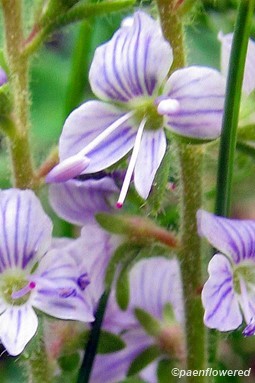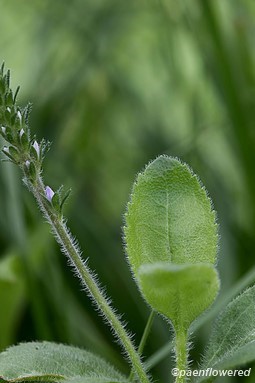Veronica officinalis
Common speedwell introduced from Europe
Veronica officinalis heath speedwell
The speedwells had been members of the figwort family, but have recently have been moved to the Plantain Family. There are more than 20 species in the northern United States. The common speedwell originated in Eurasia, but naturalized in North America at an early date.
This species is a perennial, creeping, hairy plant with oval, toothed leaves. These leaves are 1.5 to 5 centimeters long and 1 to 3 centimeters wide but often narrow-based. It grows in dry soil, and fields. It blooms May through July, growing 10-30 centimeters high. The 8-millimeter flower is on a vertical spike and has four petals. The lower petal is smaller and more narrow than the other three. The flower color is light blue, lavender or white with darker purplish stripes. There are two stamens.
The plant spreads mostly by seed, but the runners may root as they spread across the ground. It is a common lawn and garden weed. The leaves are low enough on the stem to survive normal mowing. It is also called the common gypsy weed, heath speedwell, or Paul’s betony. Historically the plant has been used as a herbal remedy for coughs and gastrointestinal ailments. A bitter tangy tea can be made from the dried leaves. Health benefits have yet to be scientifically verified.
Habitat & Range
Grows in woods, roadsides, old fields, and lawns.
Present throughout the state.
| EMP: | FACU |
|---|---|
| NCNE: | FACU |
Phenology
Flowers May through September.



.jpg?v=638486340480000000)











.jpg?v=637828013470000000)




Comments
Have you spotted this plant in your area? We'd love to hear about your experience! Share your comments or questions about the plant below. Comments are moderated before posting.